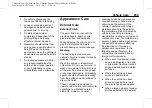
Chevrolet Low Cab Forward 6.0L Gasoline Engine 3500/4500 Series (GMNA-
Localizing-U.S.-12533400) - 2019 - CRC - 11/19/18
Vehicle Care
259
3. No vehicle should ever be
towed over 88 km/h (55 mph).
4. Loose or protruding parts of
damaged vehicles should be
secured prior to moving.
5. A safety chain system
completely independent of the
primary lifting and towing
attachment must be used.
6. Operators should refrain from
going under a vehicle which is
being lifted by the towing
equipment unless the vehicle is
adequately supported by safety
stands.
7. No towing operation which for
any reason jeopardizes the
safety of the wrecker operator
or any bystanders or other
motorists should be attempted.
Appearance Care
Exterior Care
Exterior Finish
The paint finish on your vehicle
provides beauty, depth of color,
gloss retention, and durability.
While cleaning the vehicle, do not
grip the roof marker lamps to
prevent damage or water leakage.
Washing
The best way to preserve your
vehicle's finish is to keep it clean by
washing it often.
Wash the vehicle in lukewarm or
cold water. Do not use hot water or
wash your vehicle in the direct rays
of the sun. Do not use strong soap
or chemical detergents. All cleaning
agents should be flushed promptly
from the surface and not allowed to
dry on the finish.
These vehicles are designed to
operate under normal environmental
conditions to withstand natural
elements. However, unusual
conditions such as high-pressure
car washers may cause water to
enter inside the vehicle. If the
vehicle is operated with foreign
material adhering to the exterior,
this material may react chemically
with paint, resulting in staining,
discoloration, rusting or corrosion of
components. Also, the material may
become trapped within mechanical
components, adversely affecting
their functions or forming an
aerodynamic resistance. In the
following cases, therefore, the
vehicle must be washed and all
foreign matter removed.
.
When soot, iron powder, dead
bugs, bird droppings, tree sap,
or oily matter from coal tar and
smoke has adhered to painted
surfaces.
.
When the vehicle has been
driven in coastal areas
.
When the vehicle has been
driven on roads where road
chemicals have been applied
.
When a large amount of mud or
dirt has adhered to the exterior











































